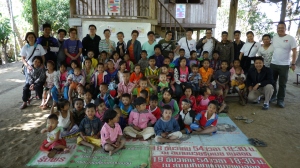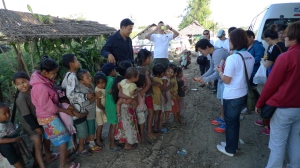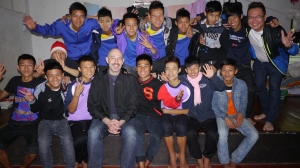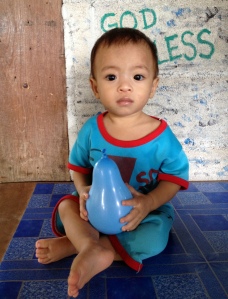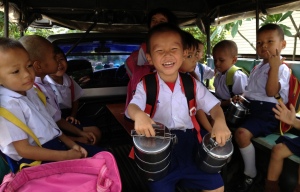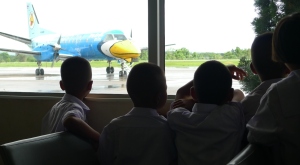With just a few days left before I begin my new job, I took the opportunity to join a group of friends from Project LOVE Asia for four nights of volunteering in Mae Sot, a town along the Thai-Myanmar border. Our job was to help bring Christmas to the children at the Heavenly Home orphanage and the young adults at the Love & Care learning center.
Let me share some pictures and some brief notes about the experience.
Day 1
The first day, we went to a “day care” that is run by the orphanage. Located a few miles away in the midst of rice paddies, the structure is just a shack and a broad roof over a packed-dirt floor. Volunteers provide free lunch and basic education for the children of itinerant farmers and laborers four days a week.
Our group of volunteers (who are not the normal day-to-day volunteers at the day care) played games with the children and then before lunch, gave them a lesson in proper hand-washing technique including teaching them the “hand washing song”.
Given that these children mostly speak Burmese or a local dialect based on their ethnic group (mostly Shan or Karen), I’m not sure they learned the song. But hopefully the basic lesson of the importance of good hand-washing was learned.
This day for lunch, the children had rice with chicken and curry. Most of the time, the orphanage cannot afford to feed them meat so today’s lunch was a special treat. The children’s parents, who are dirt-poor, do not have to pay for this day care. It is provided by donations to the orphanage.
In the afternoon, after finishing at the day care, our vans drove for nearly an hour over bumpy roads until we arrived at the middle of the provincial dump. There, we met families of illegal immigrants who earn a living sorting through the refuse and selling materials for recycling.
Their rickety shacks line the roads and their children, who are now able to receive some education thanks to a nearby school recently built by an NGO, were happy to see us and receive some Christmas treats.
That evening in the guest house while we were debriefing the day, the sound of Christmas carolers filled the air. A group of students from the Love & Care secondary school (which we would visit on Day 3) had come to sing us songs. I felt so bad for them as they had piled in the back of a pickup truck and driven 20 minutes in the chilly weather. It was a lovely surprise, though, and quite festive.
Day 2
The next day we spent at the Heavenly Home orphanage, playing with the children, organizing games, bathing and feeding them, and singing songs.
This was a particularly rewarding experience because the children are used to visitors and are very eager to play with them. It wasn’t unusual to have four youngsters balanced on my knees with another two or three trying to climb up.
 The founders of the orphanage, Thantzin and his wife Lily, are a Burmese couple who lived many years in Singapore. Unable to have their own children, they felt called by their faith to help the children of Burmese refugees and migrants in Thailand.
The founders of the orphanage, Thantzin and his wife Lily, are a Burmese couple who lived many years in Singapore. Unable to have their own children, they felt called by their faith to help the children of Burmese refugees and migrants in Thailand.
What started initially as a day care has expanded and they now care for more than 50 children whose parents have given them up as well as another dozen whose parents pick them up each evening.
While children can stay up to the age of 18, right now they only have children from the age of 3 months up to about 12 years old.
Our primary mission was to spread the spirit of Christmas so early on the evening of the 23rd, after the children had eaten their dinner and been bathed, dried, and dressed, they lined up for cake. We then went upstairs to sing songs and give gifts.
The happy family of Heavenly Home orphanage, crowded into the upstairs living area, which is also the girls’ bedroom. It was a chilly evening so everyone was bundled tight, happy at having such a fun evening.
Day 3
Our final full day was spent at Love & Care, a secondary learning center about 15 minutes outside of Mae Sot. Burmese migrants and refugees face a challenge: undocumented in Thailand, they cannot attend local public schools, but they education they may have received in Myanmar isn’t sufficient for meaningful work in Thailand. Love & Care is one of many learning centers (not “schools” as they don’t follow the curriculum of the Thai Ministry of Education) serving this group.
About 70 students live at the school, which boards all its students. They range in age from about 16-21 and many have already matriculated from secondary school in Myanmar. Love & Care offers grades 10-12 taught in Burmese, English, and Thai.
While there, I did interviews of several of the students and faculty. Their parents are almost uniformly farmers or laborers and one common thread is that none of them seem to be the oldest child. While I didn’t clarify why this is, I would guess that the oldest child is needed to help on the farm and it is only once you have several children that you can consider sending them for education.
We played many games with the students, mostly focused on team-building and other types of skills. After the games, we talked a bit about the lessons learned. A common theme among these students is that they came from different tribes – Karen, Shan, etc. – and it was at Love & Care that they first met people different from themselves and learned that people are all basically the same. Perhaps the most important lesson they have learned, considering they come from a place where deep-seeded animosity exists between different ethnic groups.
In the afternoon, we did an exercise where each student created a dream board, using paper, pens, old magazines, etc. The objective was to illustrate the dream they hold for their future. They then took turns sharing their dreams with each other. Most wanted to be doctors, nurses, teachers, or other professions that would enable them to return to their communities and help others. It is easy to imagine what a powerful impact these young people will have on the future of Myanmar.
In the evening, about half the children from Heavenly Home joined us and we had a large Christmas show. Different groups of students and children performed, gifts were given, and songs were sung. By the end of the day, many of the students had asked to connect with me on Facebook and I left with many new friends.
In the days after this trip, I’ve had several people say nice things about how generous I am, how nice it is that I did this trip, etc. In truth, it is the children and students who have been so generous and I have to admit that I’ve taken a great deal from the experience.
Each visit to Mae Sot serves as a reminder that it takes precious little to be happy in life, and that so many people barely have that. Our common humanity binds us and there is great power in showing compassion and sharing love.

